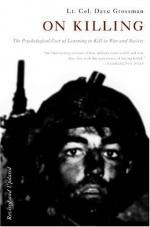
|
| Name: _________________________ | Period: ___________________ |
This test consists of 15 multiple choice questions and 5 short answer questions.
Multiple Choice Questions
1. According to Grossman in Chapter 3, what is the difference between military killing training and that provided by video games?
(a) The army directs its training toward an enemy.
(b) The army offers ballistics education.
(c) Video games stunt hand-eye coordination.
(d) There is no discernible difference.
2. What story does Grossman end Chapter 4 with?
(a) An interchange at a VFW hall.
(b) An Iraq vet's return home.
(c) A firefight in Vietnam.
(d) A firebombing in the Pacific campaign.
3. In the anecdote of Chapter 5, what consequence does the German soldier who refuses to take part in an atrocity face?
(a) Court martial.
(b) Mockery.
(c) Summary execution.
(d) Forced labor.
4. What is different about the way the way the hypothetical World War II and Vietnam vets returned home in Chapter 3?
(a) The number that are alive.
(b) The time it takes.
(c) The race of the vets.
(d) The amount of killing they were asked to do.
5. As related in Chapter 6, which catalyzing event occurred to Calley's platoon the day before the My Lai massacre?
(a) The platoon was ambushed by VC.
(b) Calley's wife divorced him.
(c) A soldier tripped a booby trap.
(d) The Golf of Tonkin incident occured.
6. In Chapter 2, what is a socially humiliating act regarding modern media?
(a) Believing the events of the film are real.
(b) Preferring older movies.
(c) Averting gaze during violence.
(d) Crying during sappy moments.
7. What is a common feature of natural warriors presented in Chapter 5?
(a) They have no religious affiliation.
(b) They experienced violence as children.
(c) They come from working class families.
(d) They join the military before the age of 25.
8. In Chapter 2, what advice do German World War I vets give World War II recruits?
(a) Kill any Russian you encounter.
(b) Surrender to the Americans.
(c) Go AWOL near the Swiss border.
(d) Do not distinguish between civilian and enemy.
9. According to Grossman in Chapter 6, why is a suicide bomber more effective than a traditional shooter?
(a) He will not lose his weapon.
(b) He can kill more victims before dying.
(c) He is less conspicuous.
(d) He cannot retreat.
10. According to Grossman in Chapter 5, what component separates a natural warrior from a psychopath?
(a) Empathy.
(b) Intelligence.
(c) Charisma.
(d) Control.
11. Which of the following theorists presents evidence concerning proximity of authority and peer groups?
(a) Swank.
(b) Milgram.
(c) Marshall.
(d) Shalit.
12. Which of the following is not an example provided in Chapter 2 of Vietnam's "dirty" combat?
(a) Killing women and children.
(b) Burning down civilian homes.
(c) Killing up close.
(d) Encroaching into neighboring countries.
13. In the Vet of the Year anecdote in Chapter 3, who did Dave use as an example of someone who did not kill but was still blamed?
(a) An ammo truck driver.
(b) A helicopter repairman.
(c) A medic.
(d) A military reporter.
14. Between 1970 and today, what increase has occurred in the number of imprisoned individuals per 100,000?
(a) 100 to 500.
(b) 150 to 400.
(c) 40 to 250.
(d) 150 to 700.
15. What cold consolation for Vietnam vets does Grossman acknowledge in Chapter 2?
(a) The end of the draft.
(b) The changes to military training policy because of the war.
(c) The successful political careers of several vets.
(d) The fall of the Soviet Union.
Short Answer Questions
1. According to Grossman in Chapter 2, what do POW executions do to an enemy?
2. What does a drill instructor teach as the root of manhood?
3. Between which two stages of the killing process is a murder-suicide fluctuating, as described in Chapter 2?
4. What mistaken impression did the ex-CIA officer whose story appears at the end of Chapter 1 have about his prisoner?
5. Which of the following is not an example of an earlier, less-detrimental media monster listed in Chapter 2?
|
This section contains 617 words (approx. 3 pages at 300 words per page) |

|




